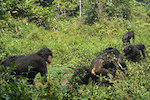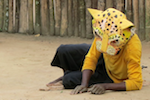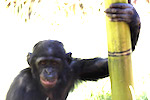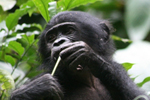
Bonobo from still of camera trap video. Courtesy of: Terese Hart.
Bonobos, our ape cousins, love peace. Unlike chimpanzees, also our close relatives, bonobos are known to resolve conflict through sex instead of aggression. They kiss, they caress, and females display genito-genital rubbing (also called G-G rubbing) to communicate, bond, and reconcile.
But capturing these elusive and endangered apes on camera is not easy.
In the north of the TL2 landscape in the Democratic Republic of Congo, named after the three large rivers it encompasses, Tshuapa – Lomami – Lualaba (from west to east), researchers from the Lukuru Wildlife Research Foundation set up several camera traps between April and July 2014, and recovered some rare footage.
In one of the videos, bonobos screech loudly, and run about. One female bonobo even kicks and displays her anger towards another female bonobo.
“We are getting some of the first ever wild footage of bonobos living as they normally do without any interference from humans or presence of humans,” Jo Thompson, bonobo-expert and President of the Lukuru Wildlife Research Foundation, told mongabay.com.
Based on what the video footage shows, Thompson deduced that the bout of aggression could be a tumescent female bonobo (bonobo with a genital swelling that signals receptivity to mating), charging an anestrus female (bonobo with a flaccid genitalia).
“Just given social dynamics, the tumescent female would be considered ‘attractive’ in that phase, while the anestrus female is not,” Thompson said. “But…without knowing the individuals or their hierarchical relationship, I can only respond to what I see.”
The video also features a mother and a child, and ends with a bonobo quickly running across the camera with a tree branch, possibly an excited adolescent male, according to Thompson.
In another part of DR Congo, south of the TL2 landscape, a bonobo was spooked by a camera.
These camera traps are part of an extensive wildlife monitoring survey in the TL2 landscape initiated by Terese Hart and her husband, John Hart, in 2007. Some other camera trap videos featuring African forest elephants, Congo peacocks, and the lesula, a monkey recently discovered by the Lakuru team and known only from the TL2 landscape in DR Congo, can be viewed on their website. In fact, a leopard attempts to click a selfie too.
Related articles
|
Why are great apes treated like second-class species by CITES? (09/11/2014) The illegal trade in live chimpanzees, gorillas, bonobos and orangutans showed no signs of weakening in the first half of 2014—and may actually be getting worse—since the Great Apes Survival Partnership (GRASP) published the first-ever report to gauge the global black market trade in great apes in 2013. |
|
How did Ebola Zaïre Get to Guinea? (08/05/2014) The vicious Ebola outbreak that has already killed over 800 people this year was not a strain endemic to the region as initially believed. Instead the University of Edinburgh found that the strain is the same as the Ebola Zaïre found in the Democratic Republic of Congo (DRC), formerly Zaïre. Does this mean the strain could have come from illegally-trafficked great apes instead of fruit bats as widely reported? |
|
Conservation controversy: are bonobos protected in the right ways and in the right places? (07/30/2014) Bonobos, endangered great apes, continue to survive in forests south of the Congo River in the DRC, albeit under constant threat of hunting, loss of habitat and the growing demands of an increasing human population. Conservationists have, over the years, tried and tested different conservation strategies to protect the last of the bonobos. And some of these strategies have invited considerable debate. |
|
Invasion of the oil palm: western Africa’s native son returns, threatening great apes (07/28/2014) As palm oil producers increasingly look to Africa’s tropical forests as suitable candidates for their next plantations, primate scientists are sounding the alarm about the destruction of ape habitat that can go hand in hand with oil palm expansion. A recent study sought to take those warnings a step further by quantifying the overlap in suitable oil palm land with current ape habitat. |
|
Setting the stage: theater troupe revives tradition to promote conservation in DRC (07/22/2014) Two years ago, environmental artist Roger Peet set off to the Democratic Republic of Congo to support the new Lomami National Park with bandanas that he designed. This time, Peet is back in Congo to carry out a conservation theater project in remote villages near the proposed Lomami National Park. |
|
Is there hope for bonobos? Researchers, NGOs, gov’t officials, local communities band together to save iconic ape (Part III) (07/18/2014) Sankuru Nature Reserve was established in 2007 primarily for bonobo protection. The largest continuous protected great ape habitat in the world, Sankuru is still losing large swaths of forests to burning and other activities, primarily along roads that transect the center of the reserve. However, hope exists, both from human efforts – and from the apes themselves. |
|
Poaching, fires, farming pervade: protecting bonobos ‘an enormous challenge’ (Part II) (07/17/2014) Sankuru Nature Reserve in the DRC was established in 2007 to safeguard the 29,000 to 50,000 bonobos that remain in existence. However, while touted as the largest swath of protected continuous great ape habitat in the world, the reserve is still losing thousands of hectares of forest every year. Burning, bushmeat hunting, and agricultural expansion are taking a large toll on the endangered great ape. |
|
Will the last ape found be the first to go? Bonobos’ biggest refuge under threat (Part I) (07/16/2014) Bonobos have been declining sharply over the past few decades. In response, several non-profit organizations teamed up with governmental agencies in the DRC to create Sankuru Nature Reserve, a massive protected area in the midst of bonobo habitat. However, the reserve is not safe from deforestation, and has lost more than one percent of its forest cover in less than a decade. |
|
Bonobos: the Congo Basin’s great gardeners (12/11/2013) The survival of primary forests depends on many overlapping interactions. Among these interactions include tropical gardeners, like the bonobo (Pan pansicus) in the Congo Basin, according to a new study in the Journal of Tropical Ecology. Bonobos are known as a keystone species, vital to the diversification and existence of their forests. |







